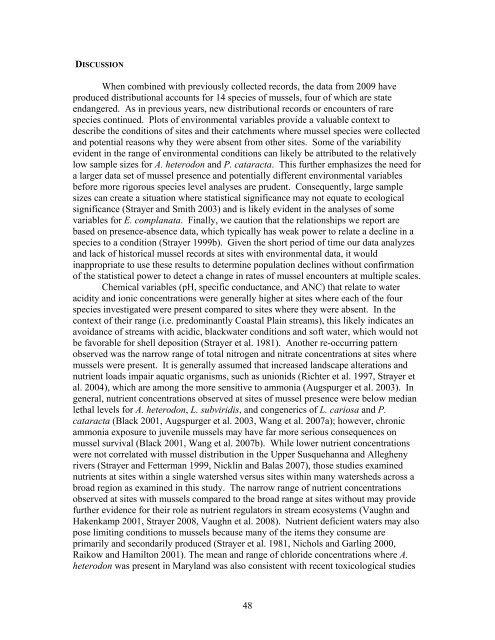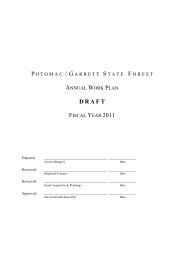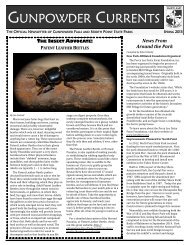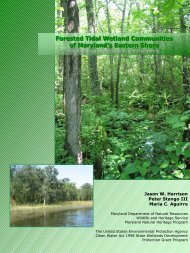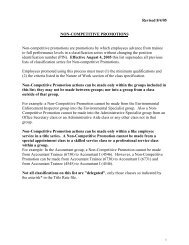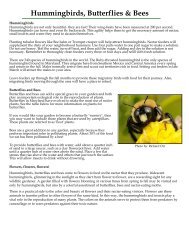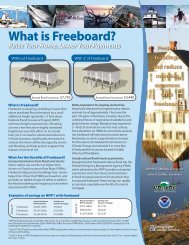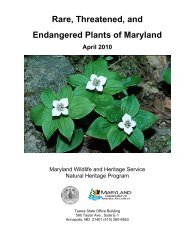Freshwater mussel records collected by the Maryland Department of ...
Freshwater mussel records collected by the Maryland Department of ...
Freshwater mussel records collected by the Maryland Department of ...
Create successful ePaper yourself
Turn your PDF publications into a flip-book with our unique Google optimized e-Paper software.
DISCUSSION<br />
When combined with previously <strong>collected</strong> <strong>records</strong>, <strong>the</strong> data from 2009 have<br />
produced distributional accounts for 14 species <strong>of</strong> <strong>mussel</strong>s, four <strong>of</strong> which are state<br />
endangered. As in previous years, new distributional <strong>records</strong> or encounters <strong>of</strong> rare<br />
species continued. Plots <strong>of</strong> environmental variables provide a valuable context to<br />
describe <strong>the</strong> conditions <strong>of</strong> sites and <strong>the</strong>ir catchments where <strong>mussel</strong> species were <strong>collected</strong><br />
and potential reasons why <strong>the</strong>y were absent from o<strong>the</strong>r sites. Some <strong>of</strong> <strong>the</strong> variability<br />
evident in <strong>the</strong> range <strong>of</strong> environmental conditions can likely be attributed to <strong>the</strong> relatively<br />
low sample sizes for A. heterodon and P. cataracta. This fur<strong>the</strong>r emphasizes <strong>the</strong> need for<br />
a larger data set <strong>of</strong> <strong>mussel</strong> presence and potentially different environmental variables<br />
before more rigorous species level analyses are prudent. Consequently, large sample<br />
sizes can create a situation where statistical significance may not equate to ecological<br />
significance (Strayer and Smith 2003) and is likely evident in <strong>the</strong> analyses <strong>of</strong> some<br />
variables for E. complanata. Finally, we caution that <strong>the</strong> relationships we report are<br />
based on presence-absence data, which typically has weak power to relate a decline in a<br />
species to a condition (Strayer 1999b). Given <strong>the</strong> short period <strong>of</strong> time our data analyzes<br />
and lack <strong>of</strong> historical <strong>mussel</strong> <strong>records</strong> at sites with environmental data, it would<br />
inappropriate to use <strong>the</strong>se results to determine population declines without confirmation<br />
<strong>of</strong> <strong>the</strong> statistical power to detect a change in rates <strong>of</strong> <strong>mussel</strong> encounters at multiple scales.<br />
Chemical variables (pH, specific conductance, and ANC) that relate to water<br />
acidity and ionic concentrations were generally higher at sites where each <strong>of</strong> <strong>the</strong> four<br />
species investigated were present compared to sites where <strong>the</strong>y were absent. In <strong>the</strong><br />
context <strong>of</strong> <strong>the</strong>ir range (i.e. predominantly Coastal Plain streams), this likely indicates an<br />
avoidance <strong>of</strong> streams with acidic, blackwater conditions and s<strong>of</strong>t water, which would not<br />
be favorable for shell deposition (Strayer et al. 1981). Ano<strong>the</strong>r re-occurring pattern<br />
observed was <strong>the</strong> narrow range <strong>of</strong> total nitrogen and nitrate concentrations at sites where<br />
<strong>mussel</strong>s were present. It is generally assumed that increased landscape alterations and<br />
nutrient loads impair aquatic organisms, such as unionids (Richter et al. 1997, Strayer et<br />
al. 2004), which are among <strong>the</strong> more sensitive to ammonia (Augspurger et al. 2003). In<br />
general, nutrient concentrations observed at sites <strong>of</strong> <strong>mussel</strong> presence were below median<br />
lethal levels for A. heterodon, L. subviridis, and congenerics <strong>of</strong> L. cariosa and P.<br />
cataracta (Black 2001, Augspurger et al. 2003, Wang et al. 2007a); however, chronic<br />
ammonia exposure to juvenile <strong>mussel</strong>s may have far more serious consequences on<br />
<strong>mussel</strong> survival (Black 2001, Wang et al. 2007b). While lower nutrient concentrations<br />
were not correlated with <strong>mussel</strong> distribution in <strong>the</strong> Upper Susquehanna and Allegheny<br />
rivers (Strayer and Fetterman 1999, Nicklin and Balas 2007), those studies examined<br />
nutrients at sites within a single watershed versus sites within many watersheds across a<br />
broad region as examined in this study. The narrow range <strong>of</strong> nutrient concentrations<br />
observed at sites with <strong>mussel</strong>s compared to <strong>the</strong> broad range at sites without may provide<br />
fur<strong>the</strong>r evidence for <strong>the</strong>ir role as nutrient regulators in stream ecosystems (Vaughn and<br />
Hakenkamp 2001, Strayer 2008, Vaughn et al. 2008). Nutrient deficient waters may also<br />
pose limiting conditions to <strong>mussel</strong>s because many <strong>of</strong> <strong>the</strong> items <strong>the</strong>y consume are<br />
primarily and secondarily produced (Strayer et al. 1981, Nichols and Garling 2000,<br />
Raikow and Hamilton 2001). The mean and range <strong>of</strong> chloride concentrations where A.<br />
heterodon was present in <strong>Maryland</strong> was also consistent with recent toxicological studies<br />
48


